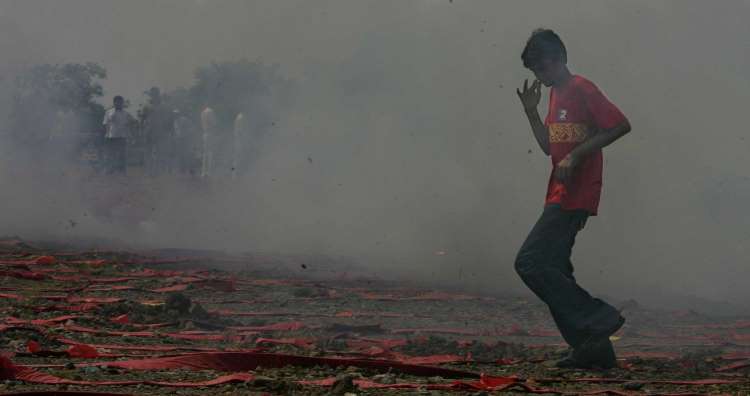With Diwali approaching, air pollution levels shoot up

Over 115,000 infants die each year in India due to complications arising from air pollution, says U.S.-based Health Effects Institute
The last fortnight has been particularly hard for nearly half the Indian population that resides in northern plains of the country. Pollution levels have ranged between severely unhealthy to sheer hazardous and even beyond, thanks in part to the stubble burning by farmers, but also due to pollution generated by industry and transport. Pollution levels in parts of the National Capital Region have been so high, for days on end, that the current meters cannot measure them anymore.
All this even before Diwali is here. While the people celebrate the festival of lights with great gusto and cheer, they wake to a sombre and dark morning as the air, heavy with deadly cocktail of noxious gases released from all the firecrackers burst on Diwali, not only burns the eyes but also tastes sour and leads to large-scale dermatological issues.
Last year, too, air pollution levels throughout the country, especially in the Indo-Gangetic plains, remained stubbornly high for nearly two weeks after Diwali.
Expensive festivals
Over the past three decades, air pollution has emerged as a serious health issue in India, along with several other countries around the world. Over 115,000 infants die each year in the country due to complications arising from air pollution. The State of Global Air 2020, by U.S.-based Health Effects Institute, says that long-term exposure to outdoor and household air pollution in India led to death of over 1.67 million people in 2019. The deaths occurred due to a variety of diseases such as stroke, heart attack, diabetes, lung cancer, and neonatal diseases, but which were complications caused by pollution. It listed air pollution as the largest risk factor for death among all health risks.
Earlier this year, a report, released by Greenpeace Southeast Asia said the annual cost of pollution from burning of fossil fuels is over USD 150 billion in India, or 5.4 pc of the country’s GDP. The Greenpeace report also said that air pollution also leads to nearly a million premature births and about 350,000 new cases of child asthma due to nitrogen dioxide. “Air pollution is a threat to our health and our economies. Every year, air pollution from fossil fuels takes millions of lives, increases our risk of stroke, lung cancer and asthma, and costs us trillions of dollars. But this is a problem that we know how to solve, by transitioning to renewable energy sources, phasing out diesel and petrol cars, and building public transport. We need to take into account the real cost of fossil fuels, not just for our rapidly heating planet, but also for our health,” says Minwoo Son, Clean Air Campaigner at Greenpeace East Asia.
“The country spends around 1.28 pc of the GDP on health while air pollution from burning fossil fuels costs an estimated 5.4 pc of India’s GDP. This year the central government allocated only INR 690 billion for the health sector in the union budget. This makes it clear that as a country we must fix our priority and stop burning fossil fuels which are harming our health and economy both,” says Avinash Chanchal, senior campaigner at Greenpeace India.
Despite paying such a heavy price for decades, most Indians seem totally oblivious to the problems of air pollution when they go bursting firecrackers to celebrate Diwali and other festivals that come back-to-back during the winter.
Half-hearted ban on firecrackers’ sale
In the absence of any clear and strong action by the government to curb the use of fireworks despite the unbreathable air, the courts have intervened finally and this year the sales of firecrackers in New Delhi as well as the neighbouring areas. The National Green Tribunal also instructed the state governments to ensure that the ban was strictly implemented in cities where the ambient air quality was poor. Even though the ban has been announced, firecrackers continue to be burst in the capital and sellers in many parts of the country say they are not aware of the ban and continue to sell the firecrackers.
With implementation being the weakest link in almost any policy in the country, the ban on firecracker sales needs to be strictly enforced. But the government needs to go beyond enforcing such bans, days before Diwali. More so with the ever present threat of Covid-19 spreading during the winter, riding on the back of illnesses induced by air pollution, the government and the people need to be much more cautious this Diwali.
Also, as air pollution is a year-long reality in practically all parts of the country, the government needs to promote different kinds of firecrackers and propel the idea of a Green Diwali by incentivising industry as well as people to adapt to the changing realities of the day. One way may be for the people to take a considered decision to avoid crackers and opt for lights and sweets as a way to mark Diwali or other festivals.
It may also be time for the Indian start-ups to come up with alternatives to the toxic crackers, with something that gives as much joy but does not leave the nation panting for breath for weeks afterwards.









